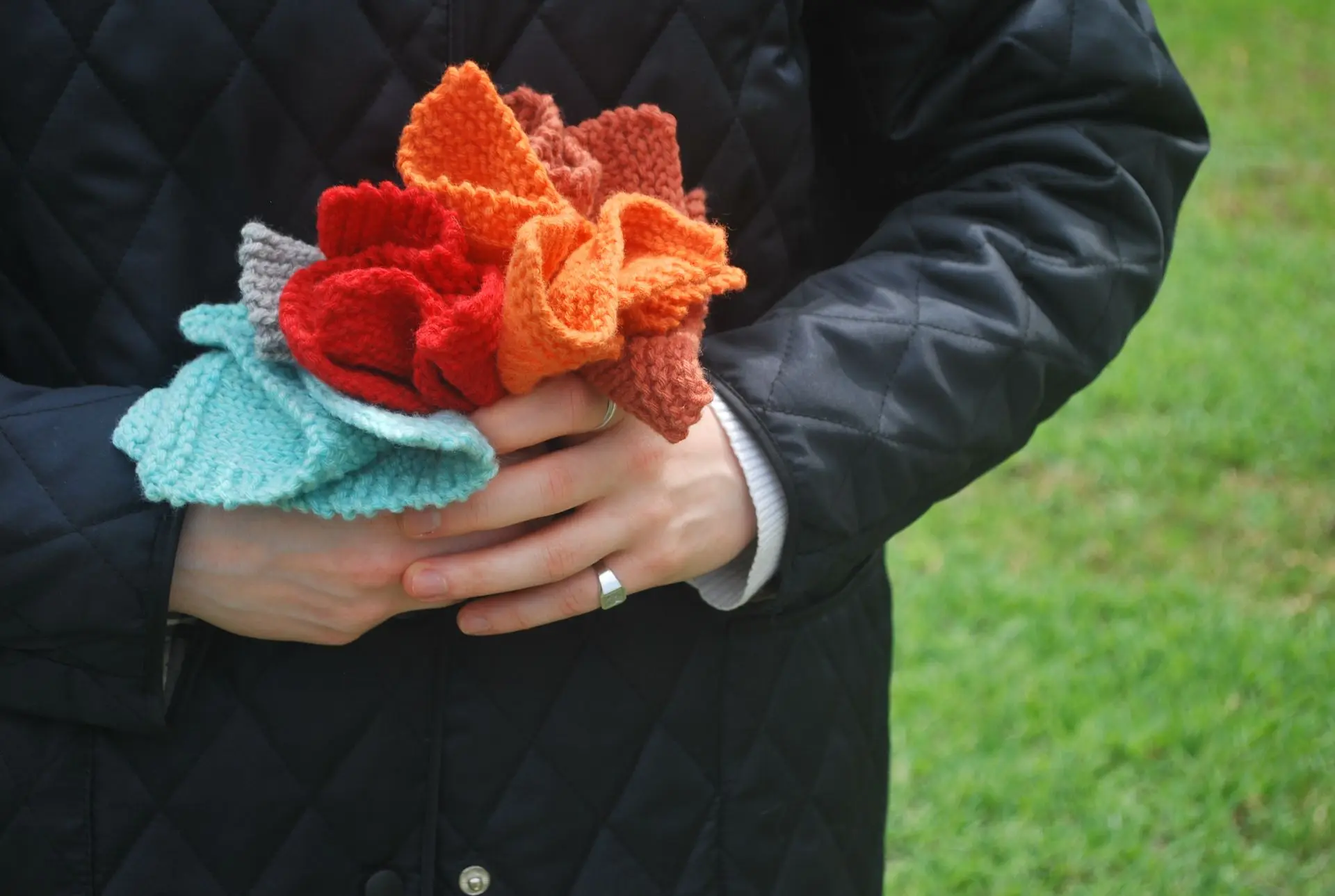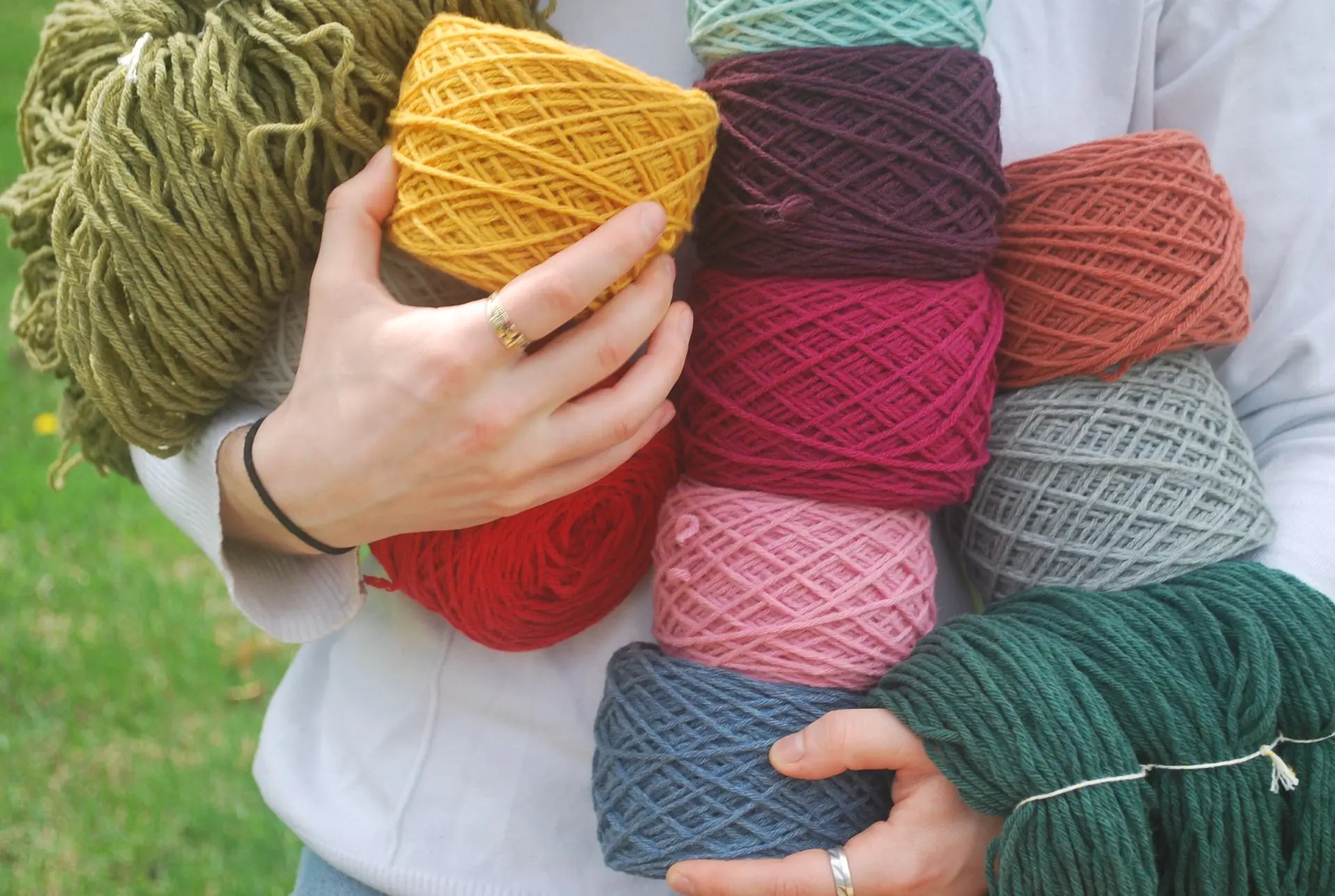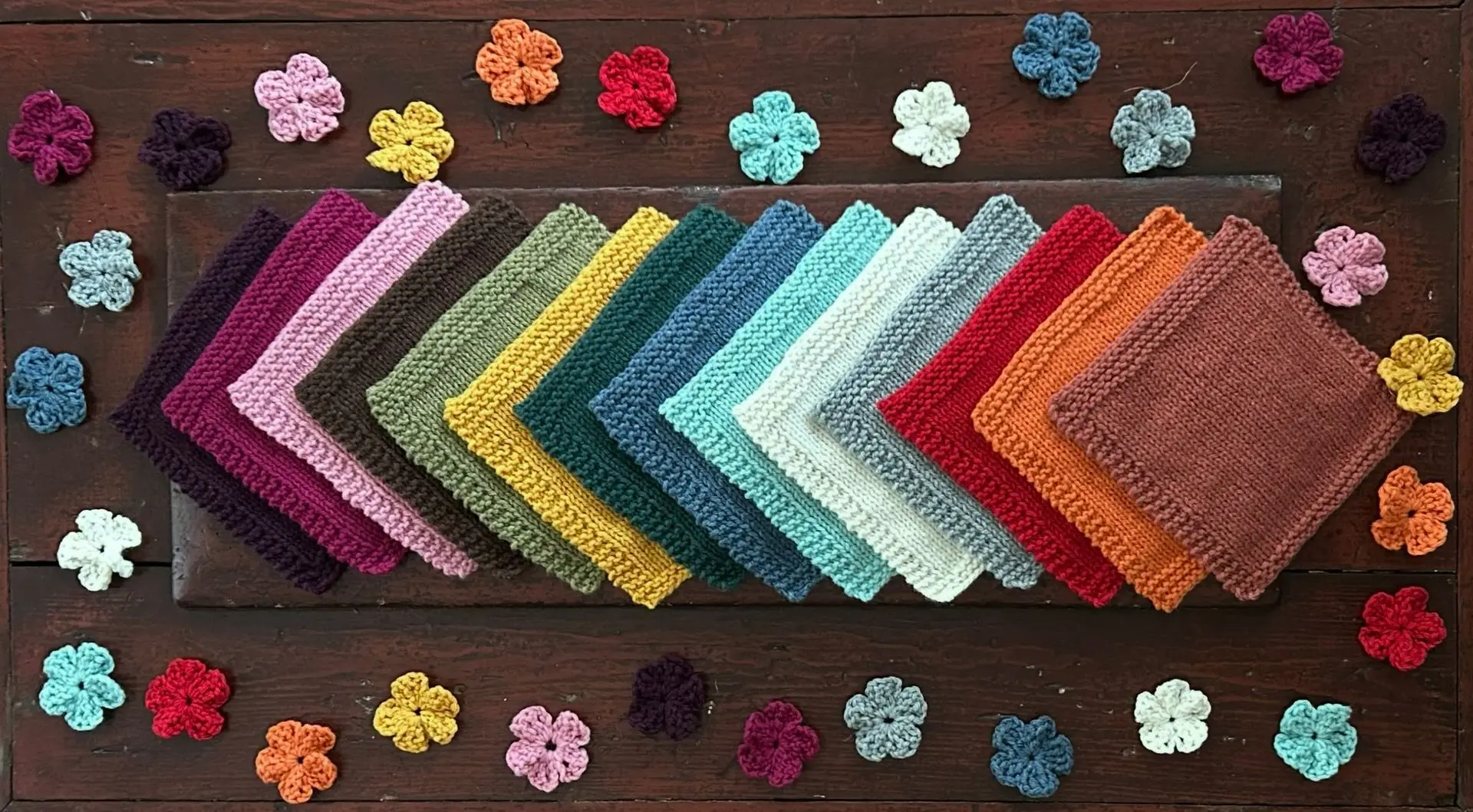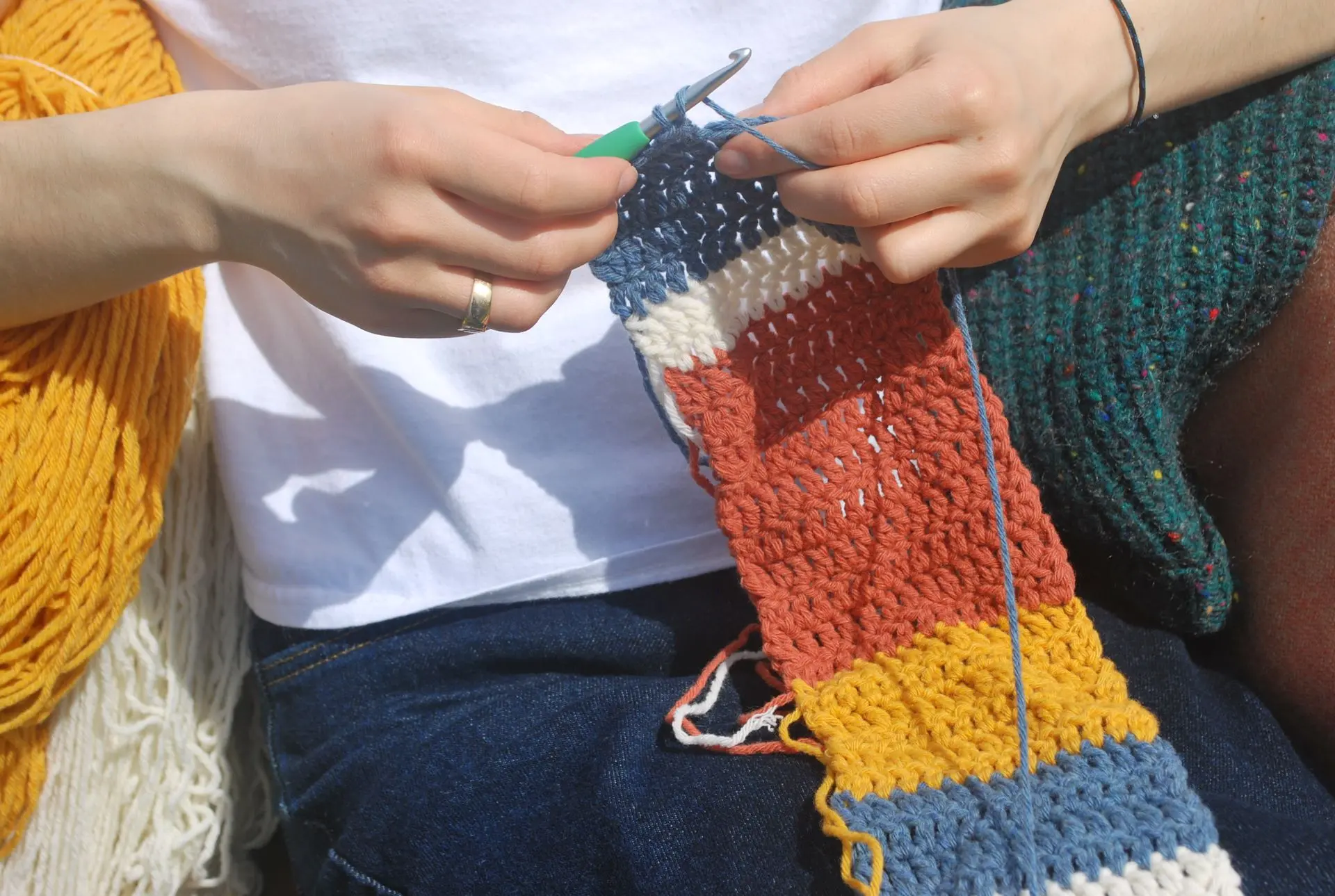welcome to wool school
learn to stitch, shape, and finish — one recycled strand at a time.
knitting stitches - your patterns' secret language
knit (k) - a knit stitch is also called a "plain" stitch. Insert the needle into the stitch from front to back, wrap the yarn around and pull it through. This is where every knitter starts, the foundation of many patterns.
purl (p) - a purl stitch is a plain stitch backwards. Insert the needle into the stitch from back to front, wrap the yarn around and pull it through. The sister stitch to knit, used to create texture.
slip stitch (sl) - moves a stitch from one needle to the other without working it.
cast on (co) - is how you start a knitting project by creating the first row of stiches on the needle. A favorite is long-tail cast on.
bind off (bo) - work (knit or purl, as indicated) 2 stitches, * pass first stitch over second stitch and off the right needle, work next stitch; repeat from * until 1 stitch remains, fasten off final stitch. Also referred to as cast off (co).
knit 2 stitches together (k2tog) - Easy way to decrease 1 knit stitch.
p2tog – purl 2 stitches together (p2tog) - Easy way to decrease 1 purl stitch.
knit front and back (KFB) – knit into the front and then into the back of the same stitch adding 1 extra knit stitch (increases 1 knit stitch).
purl front and back (PFB) – purl into the front and back of the same stitch adding 1 extra purl stitch (increases 1 purl stitch).
slip yarn in front (sl1 wyif) - creates a clean edge on knit side.
slip yarn in back (sl1 wyib) - creates a clean edge on purl side.
place a stitch marker (pm) – on the needle.
crochet stitches - the mysterious codes revealed
chain (ch) -This is the foundation of most crochet projects. You create a chain by yarning over and pulling through to create new chain stitches.
slip stitch (sl st) - A slip stitch often used to join work when working in rounds, or to move your yarn across stitches without adding height. To make a slip stitch, insert your hook, yarn over, and pull through both loops on the hook in one go. It’s as simple as that!
single crochet (sc) - The single crochet is incredibly versatile and forms the basis for many patterns and textures. To make a single crochet, insert your hook into the stitch, yarn over, pull through, yarn over again, and pull through both loops on your hook.
half double crochet (hdc) - The double half crochet is, as the name suggests, a stitch that is between a single crochet and a double crochet. It’s slightly taller than a single crochet, with a bit more texture. To make a half-double crochet, yarn over before inserting your hook into the stitch, then yarn over and pull through. You should have three loops on your hook. Yarn over again and pull through all three loops.
double crochet (dc) - The double crochet is a taller stitch. To make a double crochet, yarn over, insert your hook into the stitch, yarn over, and pull through. You’ll have three loops on your hook. Yarn over and pull through the first two loops, then yarn over and pull through the remaining two loops.
treble crochet (tr) - Also known as triple crochet, the treble crochet is an even taller stitch that’s great for creating loose, drapey fabrics. To make a treble crochet, yarn over twice before inserting your hook into the stitch. Yarn over and pull through, yarn over and pull through two loops, yarn over and pull through two loops again, and finally, yarn over and pull through the remaining two loops.
yarn weights untangled
lace (0)
Whisper-thin and delicate. Perfect for intricate shawls, doilies, and heirloom lace projects.
- Typical Gauge: 32–40 sts per 4 in (10 cm)
- Needles: US 000–1 (1.5–2.25 mm)
- Hook: 0.6–1.5 mm
- Best For: Lace shawls, lightweight wraps, airy garments
fingerling (1)
Light and fine, but with more substance than lace. Great for socks, lightweight tops, and baby knits.
- Typical Gauge: 27–32 sts per 4 in (10 cm)
- Needles: US 1–3 (2.25–3.25 mm)
- Hook: 2.25–3.5 mm
- Best For: Socks, shawls, baby clothes, lightweight sweaters
sport (2)
Soft and flexible. A touch thicker than fingering, perfect for lighter garments with a bit more warmth.
- Typical Gauge: 23–26 sts per 4 in (10 cm)
- Needles: US 3–5 (3.25–3.75 mm)
- Hook: 3.5–4.5 mm
- Best For: Kids' clothes, lightweight hats, sweaters, wraps
dk (3)
Double Knitting = Double Versatility. A popular midweight yarn, great for almost any project.
- Typical Gauge: 21–24 sts per 4 in (10 cm)
- Needles: US 5–7 (3.75–4.5 mm)
- Hook: 4.5–5.5 mm
- Best For: Sweaters, hats, scarves, baby items, home decor
worsted (4)
The classic go-to. Balanced in weight and warmth, great for beginners and everyday wear.
- Typical Gauge: 16–20 sts per 4 in (10 cm)
- Needles: US 7–9 (4.5–5.5 mm)
- Hook: 5.5–6.5 mm
- Best For: Blankets, sweaters, hats, mittens, scarves
bulky (5)
Thick, cozy, and fast. Perfect for warm winter accessories and quick makes.
- Typical Gauge: 12–15 sts per 4 in (10 cm)
- Needles: US 9–11 (5.5–8 mm)
- Hook: 6.5–9 mm
- Best For: Cowls, chunky scarves, hats, throws
super bulky (6)
Big yarn, big impact. Works up ultra-fast with major texture and warmth.
- Typical Gauge: 7–11 sts per 4 in (10 cm)
- Needles: US 11–17 (8–12.75 mm)
- Hook: 9–15 mm
- Best For: Rugs, heavy blankets, oversized scarves and sweaters
jumbo (7)
The boldest of them all. For statement knits and high drama projects.
- Typical Gauge: 6 sts or fewer per 4 in (10 cm)
- Needles: US 17+ (12.75 mm and up)
- Hook: 15 mm+
- Best For: Arm knitting, floor poufs, statement blankets




